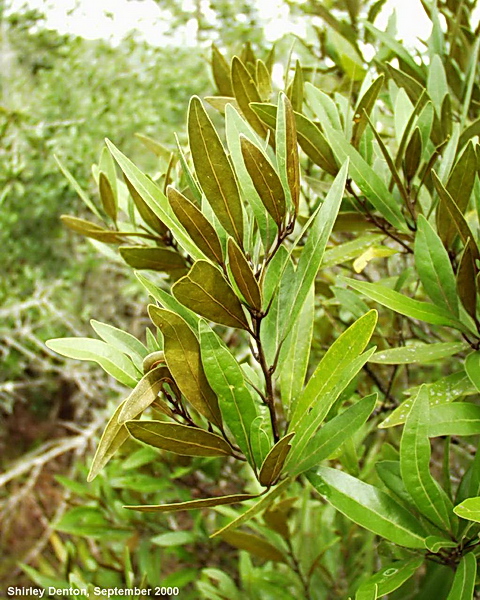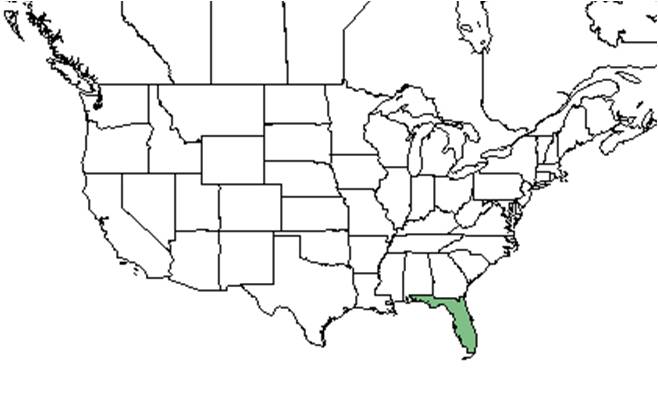Difference between revisions of "Persea humilis"
(→Ecology) |
Emmazeitler (talk | contribs) |
||
| Line 18: | Line 18: | ||
}} | }} | ||
| − | Common name: Silk bay | + | Common name: Silk bay; Scrub bay<ref name="weakley">Weakley, A.S. 2015. Flora of the southern and mid-atlantic states. Working Draft of 21 May 2015. University of North Carolina at Chapel Hill, Chapel Hill, North Carolina.</ref>. |
==Taxonomic notes== | ==Taxonomic notes== | ||
| − | Synonyms: ''Tamala humilis'' (Nash) Small; ''Persea borbonia'' var. ''humilis'' (Nash) L.E. Kopp | + | Synonyms: ''Tamala humilis'' (Nash) Small; ''Persea borbonia'' var. ''humilis'' (Nash) L.E. Kopp.<ref name="weakley">Weakley, A.S. 2015. Flora of the southern and mid-atlantic states. Working Draft of 21 May 2015. University of North Carolina at Chapel Hill, Chapel Hill, North Carolina.</ref> |
| − | + | Varieties: none.<ref name="weakley">Weakley, A.S. 2015. Flora of the southern and mid-atlantic states. Working Draft of 21 May 2015. University of North Carolina at Chapel Hill, Chapel Hill, North Carolina.</ref> | |
==Description== | ==Description== | ||
<!-- Basic life history facts such as annual/perrenial, monoecious/dioecious, root morphology, seed type, etc. --> | <!-- Basic life history facts such as annual/perrenial, monoecious/dioecious, root morphology, seed type, etc. --> | ||
| − | A description of ''Persea humilis'' is provided in [http://efloras.org/florataxon.aspx?flora_id=1&taxon_id=233500901 The Flora of North America]. | + | A description of ''Persea humilis'' is provided in [http://efloras.org/florataxon.aspx?flora_id=1&taxon_id=233500901 The Flora of North America]. It is a tree/shrub with shiny, green leaves. The lower leaf surface has dense, appressed hairs with a rusty or blackish color, depending on the age. They are uniform across the surface of the veins. These hairs on the lower side of the leaf help reduce water loss. The peduncles are 1-3 cm long and the leaf blades are 5-8 cm long.<ref name="weakley">Weakley, A.S. 2015. Flora of the southern and mid-atlantic states. Working Draft of 21 May 2015. University of North Carolina at Chapel Hill, Chapel Hill, North Carolina.</ref> |
| − | |||
| − | |||
==Distribution== | ==Distribution== | ||
Revision as of 16:27, 16 November 2020
| Persea humilis | |
|---|---|

| |
| Photo by Shirley Denton (Copyrighted, use by photographer’s permission only), Nature Photography by Shirley Denton | |
| Scientific classification | |
| Kingdom: | Plantae |
| Division: | Magnoliophyta - Flowering plants |
| Class: | Magnoliopsida – Dicotyledons |
| Order: | Laurales |
| Family: | Lauraceae |
| Genus: | Persea |
| Species: | P. humilis |
| Binomial name | |
| Persea humilis Nash | |

| |
| Natural range of Persea humilis from USDA NRCS Plants Database. | |
Common name: Silk bay; Scrub bay[1].
Contents
Taxonomic notes
Synonyms: Tamala humilis (Nash) Small; Persea borbonia var. humilis (Nash) L.E. Kopp.[1]
Varieties: none.[1]
Description
A description of Persea humilis is provided in The Flora of North America. It is a tree/shrub with shiny, green leaves. The lower leaf surface has dense, appressed hairs with a rusty or blackish color, depending on the age. They are uniform across the surface of the veins. These hairs on the lower side of the leaf help reduce water loss. The peduncles are 1-3 cm long and the leaf blades are 5-8 cm long.[1]
Distribution
P. humilis is limited to the scrubs of the Florida peninsula.[2]
Ecology
Habitat
It is endemic to rosemary and sand pine scrubs in peninsular Florida.[3]
Pollination
The following Hymenoptera families and species were observed visiting flowers of Persea humilis at Archbold Biological Station: [4]
Colletidae: Colletes brimleyi, C. nudus
Halictidae: Augochlorella aurata, Augochloropsis metallica
Sphecidae: Bicyrtes quadrifasciata, Cerceris fumipennis
Vespidae: Euodynerus apopkensis, Polistes metricus, Pseudodynerus quadrisectus
Conservation and management
Cultivation and restoration
Photo Gallery
References and notes
- ↑ 1.0 1.1 1.2 1.3 Weakley, A.S. 2015. Flora of the southern and mid-atlantic states. Working Draft of 21 May 2015. University of North Carolina at Chapel Hill, Chapel Hill, North Carolina.
- ↑ Cite error: Invalid
<ref>tag; no text was provided for refs namedfloridata - ↑ [[1]]NatureServe. Accessed: February 20, 2016
- ↑ Deyrup, M.A. and N.D. 2015. Database of observations of Hymenoptera visitations to flowers of plants on Archbold Biological Station, Florida, USA.